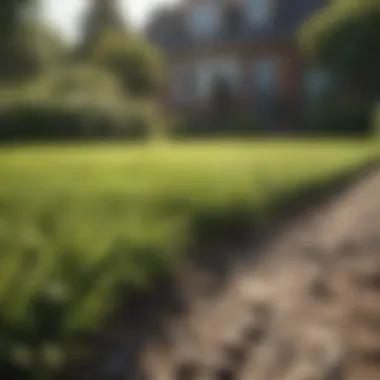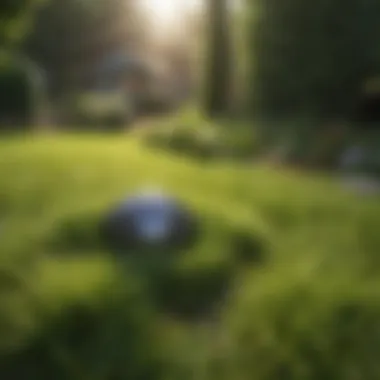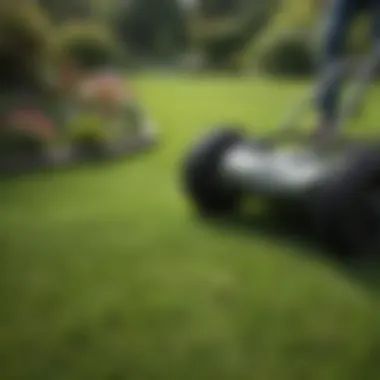Understanding the Causes of Bare Spots in Lawns


Intro
Bare spots in lawns are a common problem faced by homeowners and gardening enthusiasts. Understanding the reasons behind these unsightly patches can assist in restoring a lush and healthy lawn. Various factors play a role in the development of bare spots. These factors can be broadly categorized into biological, environmental, and maintenance-related issues. Identifying the root causes can lead to practical solutions.
The importance of knowing why these spots occur cannot be understated. This understanding equips lawn caretakers with the necessary knowledge to address these problems effectively. Additionally, it helps in improving the overall health of the lawn. A well-kept lawn increases property value and creates an inviting outdoor space for relaxation and entertainment.
By exploring the causes of bare spots, this article aims to provide actionable insights. Homeowners will learn not only what may be harming their lawns but also how to remedy these issues. Let’s delve deeper into the world of lawn health.
Intro to Bare Spots in Lawns
Bare spots in lawns present a common challenge for homeowners and enthusiasts alike. The existence of these uninviting patches can detract from the overall aesthetics of a landscape, affecting not only its beauty but also its health. This article delves into the many causes behind these unsightly areas, offering insight that is essential for maintaining a lush lawn.
Understanding Lawn Health
A healthy lawn is characterized by its density, color, and resilience. When the balance of nutrients, sunlight, and moisture is disrupted, it can lead to bare patches. These areas not only represent a visual issue but also indicate underlying problems that could escalate if not addressed. Understanding the health of your lawn involves recognizing factors such as soil quality, watering practices, and seasonal variations. Each element plays a crucial role in promoting vigorous grass growth.
Two primary components influence lawn health:
- Biological factors: These include pests and diseases that might attack grass.
- Environmental influences: Weather, soil conditions and human activities.
To restore a lawn, one must assess and address these underlying issues.
Importance of Addressing Bare Spots
Ignoring bare spots can lead to increased weed growth and further degradation of lawn quality. Weeds are opportunistic and can fill bare areas quickly, outcompeting the grass for resources. Furthermore, neglected patches can become larger over time as the health of the surrounding grass declines.
Addressing bare spots is critical for:
- Aesthetic appeal: A lush, even lawn contributes to the overall charm of a property.
- Property value: Well-maintained landscapes can increase curb appeal and, subsequently, property value.
- Environmental health: A healthy lawn contributes positively to local biodiversity by providing habitat for various organisms.
In summary, understanding the causes of bare spots and their impact on lawn health is foundational for any homeowner wishing to maintain a vibrant outdoor space.
Biological Causes of Bare Spots
Understanding the biological factors behind bare spots in lawns is essential for anyone seeking to restore their green spaces. This section delves into specific biological causes, primarily focusing on pests, insects, and diseases. Recognizing these issues is crucial. They can significantly impact the health of your lawn and the effectiveness of any remedial measures you might employ.
Pests and Insects
Common Lawn Pests
Common lawn pests, such as grubs, chinch bugs, and armyworms, are significant contributors to the deterioration of lawn health. Their presence can lead to noticeable bare patches, affecting not only aesthetics but also the vitality of the grass. One key characteristic of these pests is their ability to rapidly multiply when conditions are favorable, creating extensive damage in a short period.
It's important to identify and manage pest populations early to prevent severe damage.
Common lawn pests can proliferate during warm months, highlighting the need for vigilance and proper lawn management. The unique feature of these pests is their varied feeding habits, which can range from nibbling at the roots to undermining the structural integrity of the grass blades. The disadvantage is that a lack of early identification can result in increased costs and labor for restoration once damage occurs.
Signs of Infestation
Identifying signs of infestation is critical for proper lawn maintenance. Typical indicators include discolored grass, patches of dying or dead foliage, and increased activity from birds and other wildlife hunting for pests. A key characteristic of these signs is their visibility; they often serve as the first warning for homeowners.
Noticing these signs early can allow for immediate intervention, helping to prevent extensive damage. Unique features of signs of pest infestation include unusual patterns in the lawn's texture and color. The advantage of early recognition and identification is that it can save both time and money. When spotted on time, treatments can be administered effectively to restore lushness.
Control Methods
Implementing control methods is necessary once pests are identified. Options include chemical treatments, natural remedies, and maintaining proper lawn care practices. A key characteristic of control methods is their adaptability, allowing homeowners to choose a strategy that fits their environmental and personal preferences.
Control methods can be very effective if applied correctly and promptly. The unique feature here is the availability of both preventative and reactive solutions, from insecticidal treatments to beneficial nematodes. An advantage of this extensive range is that homeowners can combat infestations using eco-friendly options, supporting healthier lawns while minimizing chemical applications.
Diseases
Fungal Infections
Fungal infections pose a serious threat to lawn health. Types like brown patch and dollar spot can wreak havoc if left unchecked. The main aspect of these infections is their ability to spread in humid or damp conditions, making it crucial for homeowners to understand the environmental factors contributing to their proliferation.
Fungi can create visible signs, such as irregular patches and discolored spots on the grass blades. Recognizing these signs early is key to mitigating further damage. The advantage is that effective treatments exist. These range from improved air circulation and proper watering practices to fungicides specifically designed to combat lawn diseases.
Bacterial Issues
Bacterial issues in lawns can lead to wilted grass and necrotic lesions. Identifying the specific type of bacteria is essential since different species may require different treatments. The characteristic of bacterial issues is their potential to persist in moist environments, leading to recurring problems if not addressed properly.
Detecting bacterial issues early can help in applying effective solutions, such as crop rotation and proper sanitation. However, homeowners may find that dealing with bacterial issues can be complicated, as not all bacteria manifest visible symptoms. The advantage is gaining a comprehensive understanding of lawn care can lead to preventative strategies to avoid adverse effects on the grass.


Preventive Measures
Preventive measures constitute a critical part of maintaining lawn health against biological factors. Proper watering, optimizing soil quality, and timely lawn aeration are essential practices. The key aspect is that prevention is generally easier and less expensive than dealing with widespread damage post-occurrence.
Unique features of preventive measures involve maintaining a balanced nutrient supply and following recommended mowing practices to enhance grass resilience. Homeowners who adopt these practices can significantly reduce the likelihood of diseases affecting their lawns. The advantage lies in creating a robust lawn system that can withstand pest and disease pressures more effectively.
Environmental Factors
Understanding environmental factors is crucial when exploring causes of bare spots in lawns. These elements directly influence the health and appearance of grass, and their effects can be profound. When conditions are favorable, lawns thrive and resist issues; however, adverse environmental factors can create significant setbacks.
Soil Quality
Soil quality is a foundation of lawn health. Its characteristics dictate how grass will grow and its resistance to diseases or pests.
Soil Compaction
Soil compaction occurs when soil particles are pressed together, reducing pore space. This situation leads to poor aeration and drainage. Without adequate air exchange, critical root functions weaken, making grass susceptible to stress. Compact soil can hinder water absorption and nutrient availability.
Another key characteristic of soil compaction is its effect on root development. Roots struggle to penetrate compacted soil, which can inhibit growth. Therefore, addressing soil compaction is a common and beneficial practice in lawn care. Depending on the degree of compaction, homeowners might consider aeration or adding organic matter to improve soil structure.
Nutrient Deficiency
Nutrient deficiency encompasses several elements like nitrogen, phosphorus, and potassium. When these nutrients are lacking, grass cannot perform optimally, leading to weak and unhealthy growth. Deficient lawns are often more vulnerable to diseases and pests.
A primary characteristic of nutrient deficiency is its visibility. Affected areas may turn yellow or become sparse. This is an important consideration for those seeking a lush lawn. Regular soil testing is recommended to identify deficiencies accurately. Once identified, appropriate fertilizers can restore balance, ensuring grass receives essential nutrients for robust growth.
Testing Soil Health
Testing soil health is a vital step. It provides insights into pH levels, nutrient content, and overall soil condition. Homeowners can utilize home kits or send samples to labs for analysis.
A notable feature of soil testing is its role in informed decision-making. Results guide on which amendments should be applied to correct deficiencies or adjust soil acidity. This precision is beneficial because it promotes a healthier lawn environment. By routinely testing soil health, homeowners can implement proactive measures, preventing issues like bare spots from arising.
Watering Issues
Watering is another environmental factor impacting lawns significantly. Establishing a proper watering schedule is essential for maintaining a vibrant lawn.
Overwatering
Overwatering occurs when grass receives more water than it can absorb. This leads to waterlogged soil, suffocating roots. Symptoms include yellowing grass and increased fungal growth.
The key characteristic of overwatering is its timing. Many homeowners mistakenly water without considering recent rainfall or moisture levels. Managing watering habits can save water and support healthier grass. An efficient approach is to establish a routine while observing weather patterns.
Underwatering
Underwatering happens when grass does not receive sufficient moisture, leading to drought stress. Symptoms are typically browning patches and overall wilting. Grass roots become weak in search of water, resulting in a poor lawn appearance.
Homeowners must note the warning signs of underwatering. Establishing a consistent watering schedule is essential. Common advice is to water deeply but less frequently to encourage robust root development.
Irrigation Techniques
Choosing the right irrigation techniques can determine the effectiveness of watering practices. Different methods range from manual sprinkling to automatic systems.
A vital aspect of proper irrigation techniques is efficiency. Systems that target root zones can minimize water waste, delivering hydration directly where it’s needed most. This not only conserves water but also promotes a healthy lawn while reducing the likelihood of over or underwatering conditions.
Weather and Climate Impacts
Understanding the impact of weather and climate on lawns helps homeowners find effective solutions for maintaining lawn health. Various weather conditions can create stress on grass, potentially leading to bare spots. Evaluating these weather-related factors allows one to develop strategies to mitigate their effects. Ultimately, acknowledging climate influences promotes better lawn care and can preempt problems before they escalate.
Temperature Fluctuations
Heat Stress
Heat stress occurs when temperatures rise significantly, causing grass to struggle with water intake and cooling mechanisms. The grass may turn brown and become dormant. This is problematic, as it directly contributes to bare spots. During this period, homeowners may observe areas of grass wilting or discoloring, which signals stress. Monitoring temperature and ensuring adequate watering can prevent further damage to the lawn.
The key feature of heat stress is its role in reducing lawn vitality. Homeowners who want healthy lawns must understand its effects. While grass species vary in heat tolerance, common lawns suffer notably without proper care during hot spells.
- Advantages: Understanding heat stress can help in developing watering schedules that align with temperature.
- Disadvantages: Heavy watering during heat stress can lead to other problems, such as overwatering or reduced soil compaction.
Frost Damage
Frost damage leads to lawn deterioration during colder months when temperatures drop below freezing. Grass may show signs of frost damage through wilting or browning. This phenomenon can be particularly significant in early spring and late fall when suhu variations are common.
Understanding frost damage is crucial for any homeowner. It emphasizes the importance of selecting appropriate grass types that can withstand colder temperatures.


- Advantages: Choosing resilient grass species can minimize frost-related issues in the future.
- Disadvantages: Some grass types may become weak due to frequent exposure to frost. This makes them prune to diseases once the warmer months arrive.
Precipitation Variability
Effects of Drought
Drought significantly affects lawn health by leading to water scarcity. As grass receives insufficient water, it begins to suffer from stress, resulting in brown patches or complete dead spots. The effects of drought are often seen more in hot climates, where rainfall may be irregular. Homeowners need to be proactive during dry spells by implementing irrigation systems that efficiently distribute moisture.
Understanding the implications of drought is important. It fosters awareness of when to supplement rainfall with additional watering.
- Advantages: Timely management lowers the risk of extensive damage during droughts.
- Disadvantages: Overreliance on artificial watering can increase costs and lead to potential aquifer depletion.
Impacts of Heavy Rain
Heavy rain can lead to waterlogged soil, resulting in poor drainage and compaction. This condition often suffocates the grass roots. There can be increased susceptibility to diseases and pests as the saturated conditions foster growth that may harm the lawn. Homeowners must pay attention to drainage issues and prioritize soil aeration and proper irrigation practices.
The impact of heavy rain is essential in maintaining lawn health. Recognizing drainages and modifying landscape features can mitigate serious damage.
- Advantages: Good drainage options can prevent compaction and promote healthier root systems.
- Disadvantages: Installation of drainage systems can be labor-intensive and costly.
Proper awareness of the local weather patterns allows homeowners to better prepare for potential threats to their lawns. Taking action based on seasonal forecasts can significantly improve the resilience of the green space.
Lawn Maintenance Practices
Lawn maintenance practices play a vital role in preserving the health and appearance of your lawn. By implementing effective strategies, homeowners can greatly reduce the occurrence of bare spots. Maintenance practices encompass various activities, including mowing, fertilizing, watering, and aerating. The main goal is to maintain a thick and resilient turf that can withstand environmental stresses, pest pressures, and foot traffic. Understanding these practices helps in identifying how proper care can ultimately support lawn sustainability.
Mowing Techniques
Height Preferences
A significant consideration in lawn care is the height at which grass is cut. Different grass types have specific height preferences that relate directly to their health and density. Cutting grass too short can damage roots and promote weed growth, leading to bare spots. Maintaining the recommended height allows the grass blades to photosynthesize efficiently, ensuring robust growth. Furthermore, taller grass develops a deeper root system which aids in water retention.
Benefits of adhering to height preferences include:
- Improved resilience against drought
- Enhanced shade for soil, which suppresses weeds
- Greater overall lawn health
However, one challenge is adapting to different seasons. During the growing season, grass may require a higher cut, whereas offseason maintenance often calls for shorter cuts.
Blade Quality
Equally important is the quality of the mower blades used for cutting grass. Sharp blades are essential as they provide a clean cut, which reduces wear on the grass. Blunt or damaged blades tear the grass, making it vulnerable to diseases and pests. This contributes to the development of bare spots.
Investing in high-quality blades can lead to several advantages:
- Promotes better recovery after mowing
- Reduces stress on the turf
- Limits avenues for disease introduction
Homeowners need to ensure that mower blades are consistently sharpened and replaced when necessary. Failing to do so can negatively impact overall lawn health.
Fertilization and Care
Fertilization is a crucial element in lawn maintenance. It fosters growth by providing essential nutrients to the grass. Different fertilizers contain varying ratios of nitrogen, phosphorus, and potassium, impacting their suitability for specific needs. Understanding the types of fertilizers and their application can yield a lush, green lawn.
Types of Fertilizers
Fertilizers can be categorized into two main types: organic and synthetic. Organic fertilizers, like compost and manure, enrich the soil gradually, improving its structure over time. Synthetic fertilizers deliver nutrients rapidly, but they can lead to nutrient runoff if not used judiciously.
Choosing the right type of fertilizer depends on various factors:
- Soil condition
- Grass type
- Specific lawn issues, such as nutrient deficiency or pest problems
The key characteristic of both fertilizer types comes down to how they impact the soil biome and grass vigor. Organic options are generally safer for the environment but may require more time to show visible results.
Timelines for Application
The timing of fertilizer application is essential for maximizing its effectiveness. Different seasons demand particular nutrient profiles. For instance, applying high nitrogen fertilizers in spring promotes lush growth, while a balanced fertilizer in late summer ensures roots are fortified for the winter.
Advantages of sticking to proper fertilization timelines include:
- Better nutrient uptake by grass
- Reduced risk of nutrient waste
- Improved lawn response to fertilization efforts
Failing to observe these timelines can lead to undernourished grass or increased susceptibility to diseases. Thus, staying informed on optimal times to apply fertilizers is crucial for a thriving lawn.


"Proper lawn maintenance practices lead to healthier grass and fewer bare spots, enriching the overall landscape."
Animal Damage
Animal damage plays a significant role in the formation of bare spots in lawns. Understanding this aspect is crucial, as it allows homeowners to recognize potential threats from local fauna. Animals, both domestic pets and wildlife, can disrupt the health of a lawn through their behavior. Acknowledging these influences can lead to more effective management practices.
Pets and Wildlife
Behavioral Patterns
Domestic pets, such as dogs and cats, can create significant disturbances in lawns. Their natural instincts often lead them to dig, scratch, and mark their territory. The urination of pets can also introduce high levels of nitrogen, leading to scorch marks, while their frantic play can damage grass roots.
Wildlife, including rabbits, deer, or even raccoons, can further exacerbate lawn issues. Rabbits tend to nibble on grass and flowers, while deer can trample over larger areas. These behaviors can contribute to unsightly bare patches, which, if not managed, can spread and intensify.
The key characteristic of these patterns is their unpredictable nature. Both pets and wildlife can cause sudden damage, impacting lawn aesthetics and health in short timeframes. This unpredictability makes it essential for lawn care enthusiasts to monitor their gardens closely for signs of animal trouble.
Prevention Strategies
Implementing effective prevention strategies is vital to mitigate animal damage in the lawn. Installing physical barriers such as fences or pet gates can greatly reduce the access pets and wildlife have to the lawn. Additionally, using motion-activated sprinklers can deter larger animals.
Training pets to avoid particular areas of the yard can also yield positive results. Engaging pets in designated play areas can minimize their interaction with grass areas, promoting better overall health for the lawn. The unique feature of these strategies lies in their adaptability; homeowners can customize their approaches according to specific animal behaviors observed.
While these strategies can greatly assist in protecting lawns, it is important to consider that some animals may adapt to prevention methods over time. Thus, ongoing adjustments may be necessary to keep lawns intact and flourishing.
Understanding animal behavior and its impact is fundamental for effective lawn care. This helps in minimizing damage and promotes recovery in affected areas.
In summary, recognizing the role of animal damage is crucial for maintaining lawn integrity. Homeowners should stay vigilant about both domestic pets and local wildlife to implement suitable prevention strategies effectively.
Human Factors
Human factors play a crucial role in the overall health and appearance of lawns. The actions and decisions made by individuals can either contribute to or hinder lawn vitality. It’s essential to recognize how specific behaviors affect the landscape. This section will cover two primary elements: foot traffic and educational gaps. Addressing these factors can lead to better-maintained lawns and ultimately enhance the aesthetic appeal of outdoor spaces.
Foot Traffic
Impact of High Traffic Areas
High traffic areas significantly affect lawn condition. The constant pressure from repeated footfalls compresses the soil. This compression disrupts root growth, reduces soil porosity, and impedes water absorption. Key characteristics include noticeable wear patches and compacted ground. Maintaining these areas requires thoughtful management. High traffic zones are often associated with pathways, patios, or play zones that see regular use, making them important in a lawn's overall layout.
Despite their popularity, these zones bring certain disadvantages. Compacted soil leads to poor grass health, making it vital to analyze the impact of foot traffic on lawn health.
Restoration Techniques
Restoration techniques for damaged lawns include overseeding, aeration, and soil amendment. Key characteristics include rapid repair, which is needed for high traffic areas. These techniques can rejuvenate the soil and promote healthy growth, appealing for anyone who desires a lush lawn.
The unique feature of these methods is their ability to effectively revive stressed grass, making them beneficial in every lawn. Aeration improves soil structure, allowing roots to breathe and absorb nutrients, while overseeding fortifies thinning patches. However, coordination is necessary for effective restoration. Timing and application skills are crucial for success in restoration processes.
Educational Gaps
Common Misconceptions
Common misconceptions about lawn care greatly influence how homeowners approach maintenance. Many believe that one-size-fits-all solutions work for every lawn, which is incorrect. Key characteristics of these misconceptions include beliefs on watering frequency and mowing heights. Understanding these truths is beneficial as it encourages personalized lawn care.
The unique feature of addressing misconceptions is how it empowers owners to make informed decisions. The disadvantages of ignoring these gaps can lead to poorly maintained spaces or ineffective solutions, further amplifying the lawn's issues.
Importance of Knowledge
Importance of knowledge in lawn care cannot be overstated. Informed homeowners make better choices regarding treatments and maintenance approaches, affecting overall lawn health. Key aspects include understanding soil needs, pest identification, and appropriate mowing practices.
This comprehension is necessary and beneficial, as it fosters a caring and informed community of lawn enthusiasts. Furthermore, the unique feature of knowledge lies in its ability to create sustainable practices. Using the right methods can prevent future problems rather than simply reacting.
Effective lawn management requires addressing both human factors. A thoughtful approach not only preserves the lawn's integrity but also supports its long-term health.
Finale
Concluding this exploration of bare spots in lawns reveals the intricate web of factors influencing lawn health. Understanding these contributes to effective lawn care and appreciation of its significance for a vibrant outdoor space. The combination of biological, environmental, and maintenance-related causes interplays with each other, culminating in the appearance of those unsightly patches.
Summarizing Key Takeaways
In summary, several crucial points stand out regarding bare spots:
- Diverse Causes: Bare spots can arise from various biological factors, such as pests and diseases, coupled with environmental stressors like soil quality and weather impacts.
- Human Influence: Maintenance practices, foot traffic, and educational gaps play significant roles in exacerbating or mitigating the issue.
- Proactive Approach: Early detection and responsiveness to these causes can lead to more successful management of lawns. Recognizing signs of distress quickly makes restoration efforts more effective.
Final Recommendations
Going forward, achieving a healthy lawn requires a thoughtful approach. Here are some recommendations:
- Regular Inspections: Monitor your lawn routinely for signs of pests or diseases. Early intervention is key to prevention.
- Soil Health Testing: Conduct soil tests annually to assess nutrient levels and compaction; adjust care routines based on findings.
- Educate Yourself: Invest time in learning about lawn care techniques. Knowledge about seasonal needs, and appropriate fertilization improves lawn resilience.
By integrating these strategies, homeowners can effectively tackle the causes of bare spots and work towards nurturing a dense, green lawn.



